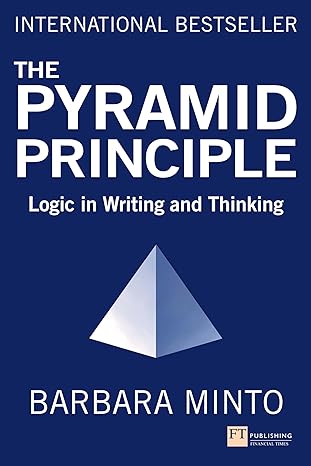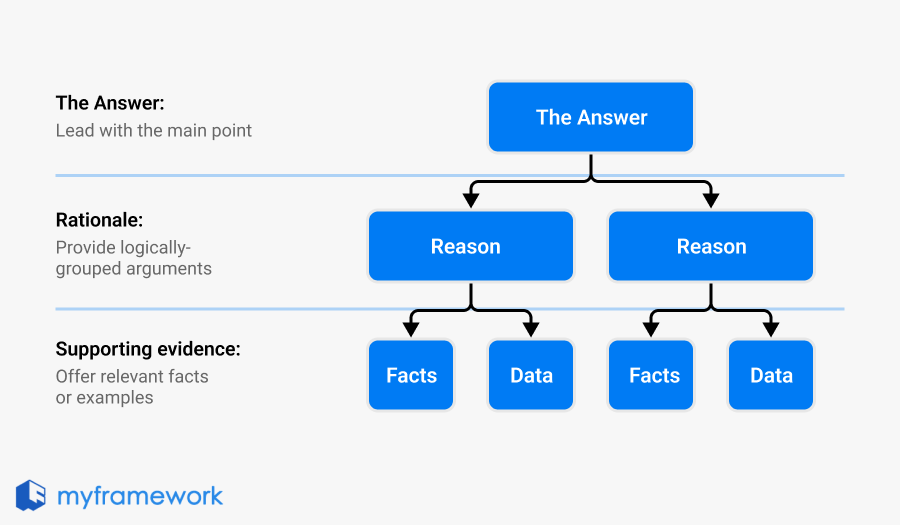A structured thinking method that starts with the main point and organizes ideas logically.
Why This Matters
Many people struggle to present ideas in a clear and convincing way. Long explanations or unstructured arguments often confuse the audience. This makes decision-making harder and weakens the impact of good ideas.
If so, the Pyramid Principle can transform your communication and thinking process.
What This Framework Is
The Pyramid Principle was developed by Barbara Minto at McKinsey & Company. It is a system thinking approach that helps organize communication in a logical and structured way.

The method uses a pyramid shape to arrange ideas: start with the main point at the top, then support it with key arguments, and finally provide detailed evidence at the base.
Minto used the metaphor of a pyramid to emphasize the importance of starting with the most important point or conclusion (the apex of the pyramid) and then building upon it with supporting layers of information (the descending layers of the pyramid).
This principle is used in business communication initially, and now it has become one of the famous system thinking models to help people structure and present ideas in a logical and persuasive manner.
How Does It Work?
The Pyramid Principle is based on three key rules:
- Start with the answer first – Communicate the main message before details. It could be a conclusion, even an assumption.
- Group related ideas – Organize supporting points into clear categories.
- Follow a logical order – Present ideas in a sequence that builds understanding. It's like explanations to support your statement.
Here is the visualization of this structure.

Implementation Scenarios
The Pyramid Principle is useful in many situations:
- Business presentations: Quickly deliver the main conclusion, then back it up with evidence.
- Reports and proposals: Organize content so that readers see the main idea first.
- Problem-solving: Break down complex issues into smaller, logical groups for better decisions.
- Team communication: Help colleagues understand priorities without confusion.
The Connection to MECE
The Pyramid Principle is closely related to the MECE (Mutually Exclusive, Collectively Exhaustive) principle.
This ensures your analysis is both comprehensive and logically structured. When applying MECE, ensure that categories within each level are distinct (no overlap) and cover all relevant aspects of the topic.
Real-World Applications
Here's how the Pyramid Principle can help in daily work and life.
Clear Communication
By starting with the main point or conclusion, the Pyramid Principle ensures that your message is clear and concise.
This is particularly useful in presentations, reports, and meetings where you need to convey complex ideas to others.
Example: In a business presentation about a new product launch, you would start with the main point (e.g., "Our new product will revolutionize the industry") and then provide supporting details such as features, benefits, market analysis, and financial projections.
Logical Structure
The hierarchical structure of the Pyramid Principle helps organize information in a logical and easy-to-follow manner.
This makes it easier for your audience to understand and retain the key points of your message.
Example: When writing a research paper, you would structure your argument using the Pyramid Principle, starting with your thesis statement (the main point) and then supporting it with evidence, analysis, and references in a logical sequence.
Persuasive Communication
By presenting your main point upfront and supporting it with strong arguments and evidence, you can make a more persuasive case for your ideas or recommendations.
Example: In a sales pitch to a potential client, you would lead with the main benefit or value proposition of your product or service, and then provide supporting details such as customer testimonials, case studies, and pricing options to reinforce your message.
Time-Saving
The Pyramid Principle helps you prioritize and focus on the most important information, saving time for both you and your audience.
Example: In a meeting with your team to discuss project updates, you would use the Pyramid Principle to highlight the key milestones, challenges, and action items upfront, and then delve into the details as needed.





